Fuels
You have two options for including the fuels used in your project. The first option is to include them from a library. The second option is to add a new fuel. You can use earlier saved sets of fuels as a starting point, when you edit data. Click on the “Fuels” section on the left vertical menu, select “Load fuel” on the top ribbon and choose the data you want to import. The imported data are now present in the editing window and can now be edited.
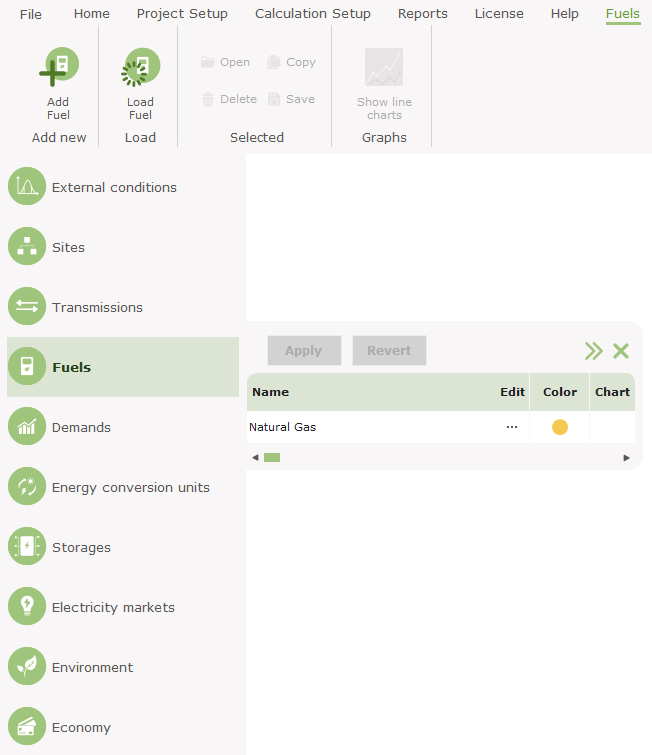
If you want to add new data then click on "Fuels" on hte left-hand vertical menu and select “Add fuel" from the tab that appears above. Additionally, you can right-click in the Graphical User Mode’s editing window, select "Add" and choose "Fuel". An empty fuel editing window is now shown, and your data can now be filled in.
Editing options for editing a specific fuel
The image below shows the editing options when editing a specific fuel. Beside the “load” and “add” options, there are the options to:
- Copy fuel – making a new copy in the fuel folder
- Rename fuel – setting the active fuel folder name in editing mode
- Delete fuel – Deleting the active fuel-folder
- Save fuel – Saving the active fuel, invoking a save dialog
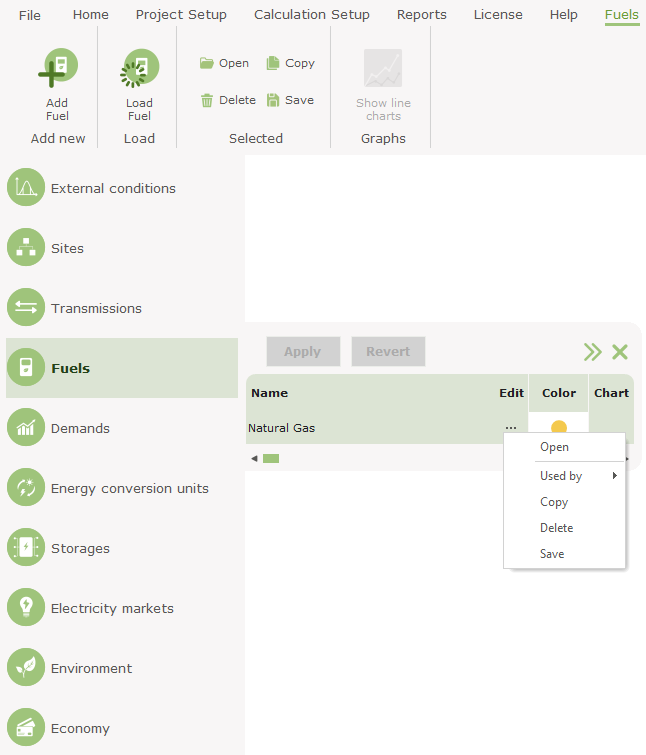
Editing the data fields

Unit
You type the name of the unit (amount), in which the fuel is delivered, e.g. biogas can be delivered in \(m^3\) (cubic meter) or it can be delivered in ‘MWh’. This unit is for information use only. The unit is for instance used in the Heat value combo-box placed to the right.
Heat value
The heat value consists of two data fields. In the first you type the heat value as a number. The second field is a combo-box in which you choose the corresponding energy unit.
In some cases, fuel in energyPRO is not necessarily used to be burned. You can use fuel to simulate any type of product included in the simulation. It can be water for hydrogen production or \(CO_2\) for methanization.
In these cases, it makes no sense to define a heat value. Therefore, you can disable the heat value.
\(CO_2\)-factor
The \(CO_2\)-factor can be enabled and a value defined. The \(CO_2\) amount can be in different units, g, kg, tonne and lb. The energy unit can either be the selected unit of the heat value or the unit of the fuel.
Use unit in graph and export
When enabling this setting, the fuel graph in production, graphic and the fuel column in energy conversion export will be shown in the unit of the fuel instead of the measuring unit of fuel.
Restrictions and storage
If you tick mark this field, you get access to restrict the fuel amount offered and to specify fuel storage.
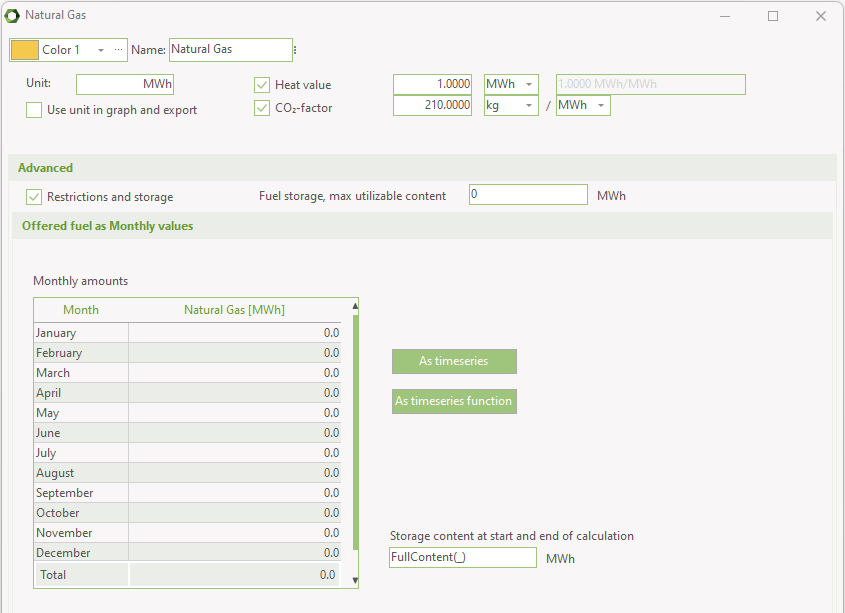
Fuel storage, max utilizable content
This parameter states the maximum utilizable content (amount) of the fuel storage.
Offered fuel
Specify how much fuel your production units are offered of the actual fuel each month. The amount of fuel that is not consumed will be put into the storage as long as it is possible. Remaining fuel will not be utilized.
As time series
You can convert the offered fuel into time series by pressing the “As time series” button. This gives you the possibility to type in data as accurate as you wish.
As time series function
You can convert the offered fuel into a time series function by pressing the “As time series function” button. Thereby, you get the option of defining a formula, very much like time series function under External conditions.
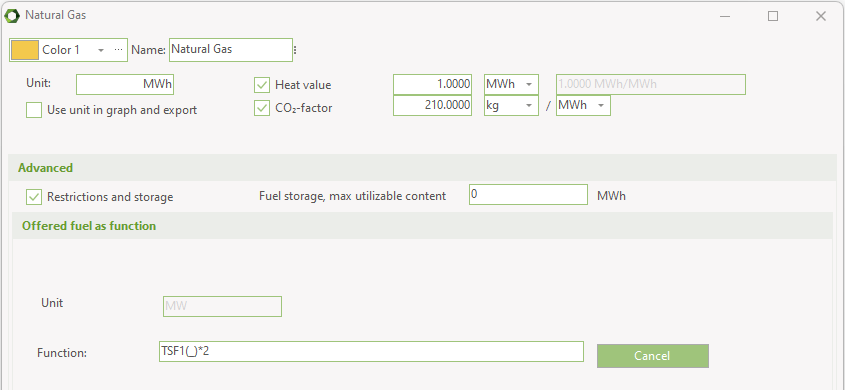
Finally, the fuel storage content at start and end of calculation can be set. This can be a fixed number, time series function or any formula.
Default, the function FullContent(_) is used. This is a function returning the capacity of the storage.
Using fuel when defining energy Unit
To make use of a fuel in your energy calculations you have to choose the fuel when defining your energy units. You can choose more fuels as input or output on the energy conversion unit. In the power curve of the fuel, you can select among a power units and the unit of the fuel, as illustrated below.
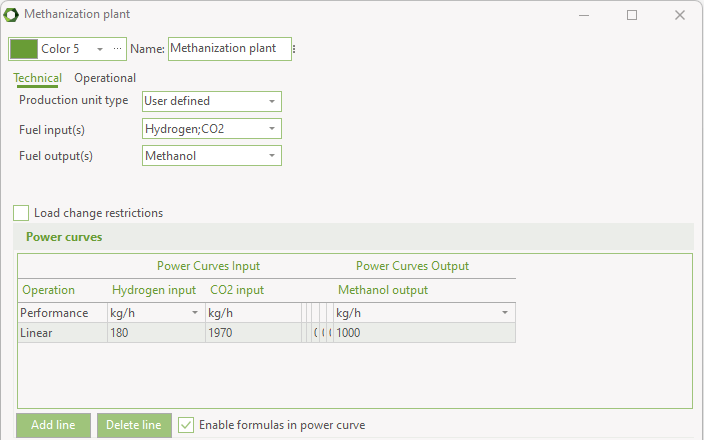
If “Fuel production” has been ticked in the “Calculation section” then a dropdown box called “Fuel output” is added below the fuel input dropdown box.